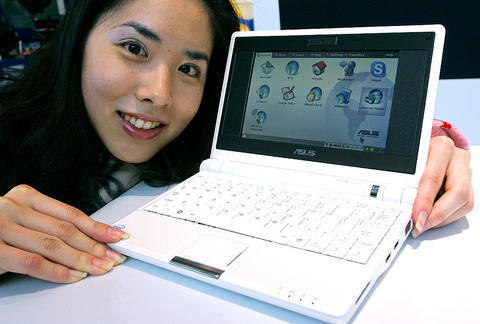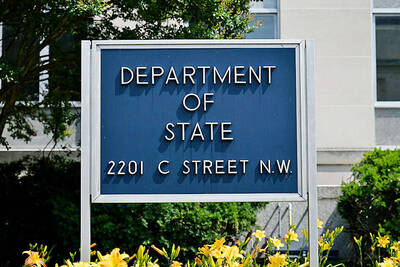It seems that the £200 (US$403) ultraportable Asus Eee PC can do no wrong. The size of a paperback, weighing less than a kilogram, with built-in Wi-Fi and using Flash memory instead of a hard drive for storage, the Eee PC has been winning positive comments across the board.
According to a survey of 1,000 users on the independent Eee PC site eeeuser.com, around 4 percent were dissatisfied with their purchase, 33 percent found the system pretty much what they expected and 62 percent thought it was even better than they had hoped.
Looking through the thousands of postings in eeeuser.com's user forums, the same comments keep coming up: It's so small, the build quality is high, it boots up quickly. In fact, it's hard to find many negative points. One thing that is almost never mentioned as a problem is the fact that the Eee PC is running not Windows, but a variant of GNU/Linux.

PHOTO: AFP
Until now, the received wisdom has been that GNU/Linux will never take off with general users because it's too complicated. One of the signal achievements of the Asus Eee PC is that it has come up with a front end that hides the richness of the underlying GNU/Linux. It divides programs up into a few basic categories and then provides large, self-explanatory icons for the main programs within each group. The result is that anyone can use the system without training or even handholding.
combination
This combination of functionality, ease of use and low price could prove problematic for Microsoft. Until now, there has been no obvious advantage for the average user in choosing GNU/Linux over Windows on the desktop and plenty of disadvantages.
The price differential has been slight and there has always been the problem of learning new ways of working. The Asus Eee PC changes all that. Because the form factor is so different, people don't seem to make direct comparisons with the desktop PC and therefore don't expect the user experience to be identical.
The price differential between the basic Eee PC running GNU/Linux and one running Windows XP is now significant as a proportion of the total cost.
That disparity seems likely to increase when Microsoft phases out Windows XP at the end of June.
At least Moore's Law should mean that the price of memory chips will continue to plummet. For example, in 2001 US$8 would have bought you around 8MB of Flash memory, whereas in 2011 it will buy you 8GB, according to projections by Gartner. As a result, Alan Brown, Gartner's research director for semiconductors, says the price of ultraportables like the Eee PC "could decline about 15 percent within three years."
This makes the relative cost of systems running Microsoft's products greater. The argument that its software is "worth more" because it has more features is unlikely to cut much ice as users discover that functionality of the kind offered by Firefox is fine for most everyday uses.
The situation in developing countries is even worse. Not only must Microsoft and its partners compete with new low-cost portable GNU/Linux systems specifically designed for these markets, like the XO-1 from the One Laptop Per Child (OLPC) project or Intel's Classmate PC, but they must also sell against unauthorized copies of Microsoft's products. To combat this, Microsoft has started selling copies of Windows for around US$3 in these markets.
SIZE DOES MATTER
Although this kind of bargain basement pricing helps make its products competitive with low-cost alternatives, Microsoft's profit margin is cut close to zero. That's not necessarily a disaster for a company with huge cash reserves, but it could be dire for one planning to take on billions of dollars of debt -- as Microsoft has said it will need to do in order to finance the acquisition of Yahoo.
Last week Microsoft cut the cost of retail copies of Vista, apparently because people don't see it as a necessary upgrade at the prices charged.
If people don't think that the extra features of Vista are worth the price it makes the argument that Windows is "worth more" than Linux harder to sustain. It's an interesting question: Just how low can the price of these "basic but good enough" portables go?
The original target price of the OLPC machine was around US$100, but its designer, Mary-Lou Jepsen, already thinks she can do better. She says that a US$75 system is "within reach" and hopes to spawn an entirely new generation of computers.
If they're to be cheap enough for people in developing countries to buy, these systems will almost certainly be using open source, but Jepsen doesn't see the zero price tag as its main advantage.
"The true and large value of free [software] is the ability to change and customize it," she said.
In other words, Microsoft could give away its software and it still couldn't compete with the truly open, customizable nature of free code. It seems that the only way Microsoft can hope to get people using its software on this new class of machines is by going fully open source itself.

A car bomb killed a senior Russian general in southern Moscow yesterday morning, the latest high-profile army figure to be blown up in a blast that came just hours after Russian and Ukrainian delegates held separate talks in Miami on a plan to end the war. Kyiv has not commented on the incident, but Russian investigators said they were probing whether the blast was “linked” to “Ukrainian special forces.” The attack was similar to other assassinations of generals and pro-war figures that have either been claimed, or are widely believed to have been orchestrated, by Ukraine. Russian Lieutenant General Fanil Sarvarov, 56, head

SAFETY FIRST: Double the number of police were deployed at the Taipei Marathon, while other cities released plans to bolster public event safety Authorities across Taiwan have stepped up security measures ahead of Christmas and New Year events, following a knife and smoke bomb attack in Taipei on Friday that left four people dead and 11 injured. In a bid to prevent potential copycat incidents, police deployments have been expanded for large gatherings, transport hubs, and other crowded public spaces, according to official statements from police and city authorities. Taipei Mayor Chiang Wan-an (蔣萬安) said the city has “comprehensively raised security readiness” in crowded areas, increased police deployments with armed officers, and intensified patrols during weekends and nighttime hours. For large-scale events, security checkpoints and explosives

PUBLIC SAFETY: The premier said that security would be tightened in transport hubs, while President Lai commended the public for their bravery The government is to deploy more police, including rapid response units, in crowded public areas to ensure a swift response to any threats, President William Lai (賴清德) said yesterday after a knife attack killed three people and injured 11 in Taipei the previous day. Lai made the remarks following a briefing by the National Police Agency on the progress of the investigation, saying that the attack underscored the importance of cooperation in public security between the central and local governments. The attack unfolded in the early evening on Friday around Taipei Main Station’s M7 exit and later near the Taipei MRT’s Zhongshan

REBUFFED: In response to Chinese criticism over recent arms sales, Washington urged Beijing to engage in meaningful dialogue instead of threats and intimidation Washington’s long-term commitment to Taiwan would not change, the US Department of State said yesterday, urging Beijing to stop pressuring Taiwan and engage in meaningful bilateral dialogues. The remarks came in response to a backlash from Beijing about Washington’s latest approval of arms sales to Taiwan. The US Defense Security Cooperation Agency said in a statement on Wednesday that the Taipei Economic and Cultural Representative Office in the US has asked to purchase an arms package, including Tactical Mission Network Software; AH-1W helicopter spare and repair parts; M109A7 self-propelled howitzers; HIMARS long range precision strike systems; tube-launched, optically tracked, wire-guided missiles; Javelin